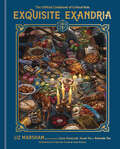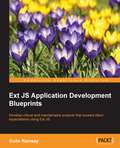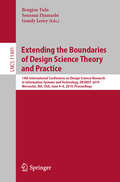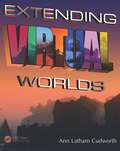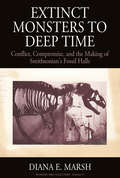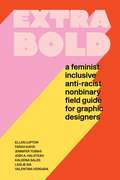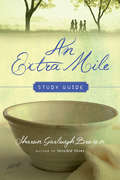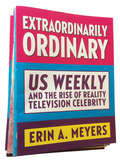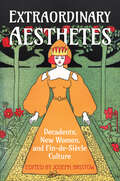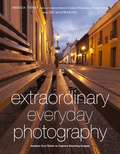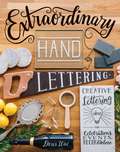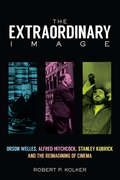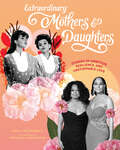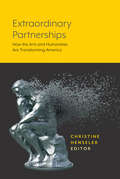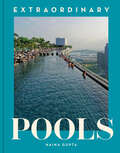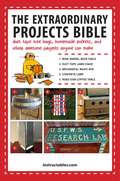- Table View
- List View
The Exquisite Book of Paper Flower Transformations: Playing with Size, Shape, and Color to Create Spectacular Paper Arrangements
by Livia Cetti&“Equips crafters with the skills for creating individual flowers and larger arrangements while providing a delightful overview on the basics of botany.&” —Publishers Weekly In The Exquisite Book of Paper Flower Transformations, artist Livia Cetti ups the ante with a host of grander and more intricate flowers and projects—more blooms, more petals, stronger stems, and bigger, bolder arrangements! Cetti will teach you how to play with size, shape, color, and texture to create twenty-five vibrant single stems in a variety of natural shapes—globes, spikes, bells, saucers, rectangles, cones, and arcs—including hydrangeas, coral charm peonies, honeysuckles, and paperwhites. Then, you&’ll use these elemental shapes to build the 15 bright, abundant arrangements, including bold wreaths, bountiful bouquets, fantastical gilded wall art, and blooming garlands. Introducing new, never-before-seen techniques for dyeing paper and creating moldable leaves and petals, this gorgeous guide is perfect for crafters of all skill levels interested in making realistic and unique home decor, gifts, accessories, and entertaining essentials. &“Unlike fresh-cut flowers, paper blooms last forever. And if you make them like floral stylist, crafter and creative director Livia Cetti, they might even be mistaken for the real thing. One of the top paper-flower artists in the U.S.&” —House & Home
Exquisite Exandria: The Official Cookbook of Critical Role (Critical Role)
by Liz Marsham Critical Role Jesse Szewczyk Susan Vu Amanda YeeFeaturing sixty delicious recipes from across the world of Critical Role, every Critter will find something to whet their appetites in this official cookbook. Join a party of culinary adventurers in search of the fabulous flavors and delightful delicacies that make Exandria so exquisite. Here, they present their bounty: sixty dishes collected from each continent! Start in Tal&’Dorei, where you can nab a trio of pastries from the Slayer&’s Cake, a staple of Whitestone&’s patisserie scene. Journey next to the birthplace of civilization, Issylra, and devour some absolutely divine Highsummer Honey Polenta. Travel to Marquet and explore Jrusar&’s Core Spire while enjoying some street meat. And finally, end in Wildemount, where you can unwind with a famous Ruby of the Sea Cocktail. The recipes from these diverse dives are accompanied by the histories of each land—and stories of iconic culinary capers by Vox Machina, the Mighty Nein, Bells Hells, and more. Enjoy Percival de Rolo&’s Revenge Pasta, stuffed with enough garlic to ward off even the strongest vampires, and blackberry and lemon hand pies inspired by Scanlan&’s favorite spell. Prepare for battle with Jester&’s Sweet Feast, a platter of pastries made complete with a dash of cinnamon and a covert sprinkle of the Dust of Deliciousness. And as the night comes to a close, settle down with Lord Eshteross&’s Maple Ginger Cookies. With a foreword by Quyen Tran and Sam Riegel, gorgeous illustrations and photography to accompany mouthwatering recipes, and lore from each corner of Exandria, this is a must-have cookbook for every Critical Role fan.
Exrta/Ordinary: Craft and Contemporary Art
by Maria Elena BuszekContemporary artists such as Ghada Amer and Clare Twomey have gained international reputations for work that transforms ordinary craft media and processes into extraordinary conceptual art, from Amer's monumental stitched paintings to Twomey's large, ceramics-based installations. Despite the amount of attention that curators and gallery owners have paid to these and many other conceptual artists who incorporate craft into their work, few art critics or scholars have explored the historical or conceptual significance of craft in contemporary art. Extra/Ordinary takes up that task. Reflecting on what craft has come to mean in recent decades, artists, critics, curators, and scholars develop theories of craft in relation to art, chronicle how fine-art institutions understand and exhibit craft media, and offer accounts of activist crafting, or craftivism. Some contributors describe generational and institutional changes under way, while others signal new directions for scholarship, considering craft in relation to queer theory, masculinity, and science. Encompassing quilts, ceramics, letterpress books, wallpaper, and textiles, and moving from well-known museums to home workshops and political protests, Extra/Ordinary is an eclectic introduction to the "craft culture" referenced and celebrated by artists promoting new ways of thinking about the role of craft in contemporary art. Contributors. Elissa Auther, Anthea Black, Betty Bright, Nicole Burisch, Maria Elena Buszek, Jo Dahn, M. Anna Fariello, Betsy Greer, Andrew Jackson, Janis Jefferies, Louise Mazanti, Paula Owen, Karin E. Peterson, Lacey Jane Roberts, Kirsty Robertson, Dennis Stevens, Margaret Wertheim
Ext JS Application Development Blueprints
by Colin RamsayIf you are a developer who has knowledge of Ext JS but would like to expand it to encompass the bigger picture of application development, then this book is ideal for you.
Extending the Boundaries of Design Science Theory and Practice: 14th International Conference on Design Science Research in Information Systems and Technology, DESRIST 2019, Worcester, MA, USA, June 4–6, 2019, Proceedings (Lecture Notes in Computer Science #11491)
by Bengisu Tulu Soussan Djamasbi Gondy LeroyThis book constitutes the thoroughly refereed proceedings of the 14th International Conference on Designing for a Digital and Globalized World, DESRIST 2019, held Worcester, MA, USA, June 2019. The 20 revised full papers included in the volume were carefully reviewed and selected from 54 submissions. They are organized in the following topical sections: Design Science Research Theory and Methodology; Design Science Research Applications in Healthcare; Design Science Research Applications in Data Science; and Design Science Research Applications in Emerging Topics.
Extending Virtual Worlds: Advanced Design for Virtual Environments
by Ann Latham CudworthWritten as the successor to Virtual World Design: Creating Immersive Virtual Environments, this book carries the ideas brought forward in its predecessor to new levels of virtual world design exploration and experimentation. Written by an Emmy award-winning designer with 22 years of experience creating virtual environments for television and online communities, Extending Virtual Worlds: Advanced Design for Virtual Environments explores advanced topics such as multi-regional design, game-based sims, and narrative structure for environments.The book provides bedrock knowledge and practical examples of how to leverage design concepts within the intertwined structures of physics engines, level of detail (LOD) systems, and advanced material editors. It also shows designers new ways to influence the experience of virtual world visitors through immersive narrative and storytelling. With over 150 illustrations and 10 step-by-step projects that include the necessary 3D models and modular components, it delivers hours of stimulating creative challenges for people working in public virtual worlds or on private grids.By using this book, novices and advanced users will deepen their understanding of game design and how it can be applied to creating game-based virtual environments. It also serves as a foundational text for class work in distance learning, simulation, and other learning technologies that use virtual environments.
Extensions of Time (Riba Good Practice Guides Ser.)
by Gillian BirkbyThis is a straight forward jargon-free practical guide about all aspects of extensions of time for all construction industry professionals. An extension of time is an issue which most architects and other construction professionals face sooner or later in their career. It is a complex area where the professional administering the contract must act in accordance with the contract conditions andfailure to do so will potentially land the professional and/or his client in court. Throughout the guide the information is presented in a way that is immediately accessible, useful and related to the latest JCT Contracts. Tables, graphs and a glossary are used to help the reader navigate through chapters on liquidated damages, terms under standard contracts, notification of delay, supply of information, assessment, concurrent delays and ethical issues. The authors have clarified potentially complex issues with short, relevant examples drawn from case law and have defined difficult concepts in easy-reference text boxes. This Good Practice Guide is a friendly reference tool for all architects or other professionals charged with assessing extensions of time.
Exterior Building Enclosures
by C. Keith BoswellA comprehensive guide to the design and execution of sophisticated exterior building enclosures Focused on the design process for architects and related professionals, this book addresses the design and execution of sophisticated exterior building enclosures for a number of commercial building types and in a variety of building materials. It focuses on the design process by delineating enclosure basics, the participants (owners, architects, engineers, consultants) and their roles and responsibilities through collaboration, and tracking the design process through construction. This comprehensive handbook covers all of the factors that affect the design of a building enclosure, including function, visual aesthetics, performance requirements, and many other criteria. In-depth case studies of projects of various scales, types, and climate conditions illustrate the successful implementation of exterior wall enclosure solutions in brick masonry, stone, architectural concrete, glass, and metals. This unique and indispensable guide: Defines the functions, physical requirements, design principles, and types of exterior building enclosures Identifies the participants in the design and construction process and specifies their roles and responsibilities Presents a step-by-step process for the design of exterior enclosures, from defining goals and developing concepts through creating construction documents Reviews the construction process from bidding and negotiation through the paper phase to the "brick and mortar" stage Provides details on the properties of exterior enclosure materials, including structural considerations, weather protection, fire safety, and more Covers a variety of materials, including brick masonry, natural stone masonry, architectural concrete, metal framing and glass, and all-glass enclosures Written by the technical director of the San Francisco office of Skidmore, Owings & Merrill, Exterior Building Enclosures is an indispensable resource for architects, engineers, facade consultants, and green design consultants working on commercial building projects.
Exteriorless Architecture: Form, Space, and Urbanities of Neoliberalism (Routledge Research in Architecture)
by Stefano CorboThe current phase of capitalist development manifests itself through a very diverse range of spatial byproducts: data centers, warehouses, container terminals, logistics parks, and many others. Generally considered as mediocre and banal examples that sit outside of pre-established disciplinary canons, these architectural episodes are extremely relevant. They are relevant not for their aesthetic or historic qualities but for what they represent – for the system of values these spaces embed. They express specific power relations, exacerbate issues of labor, and generate dramatic processes of subjectivity. Most importantly, these architectures, despite their formal and typological heterogeneity, belong to a common paradigm: the EXTERIORLESS. How can an architecture of the EXTERIORLESS be defined? How does it differentiate from examples and manifestations of the past? How do notions of legibility, form versus function, typological articulation come into play? In situating the spatialities of contemporary capitalism within the larger debate on Anthropocene, Post-Anthropocene, and Capitalocene, the book attempts to answer those questions by delineating three main characteristics for an architecture of the EXTERIORLESS: its physical and symbolic role as interface; its ambiguous condition of being at the same time local and global, isolated and connected, compressed and expanded; and, lastly, its contribution to new forms of urbanity in absence of the traditional city. These three defining aspects constitute the main sections of the book. Each section includes two chapters covering a wide spectrum of themes and examples. In its tripartite organization, the book describes the influence that the experimental architecture of the 1960s has exerted on late-capitalist spatial byproducts; it analyzes the impact of logistics on the redesign of the territory; and it introduces the radical processes of urban transformation generated by the EXTERIORLESS.
Exterminate/Regenerate: The Story of Doctor Who
by John Higgs'Absolutely wonderful. The book I've been waiting to read since I was ten years old. Full of surprising and piercing insights . . . The first thing I've come across that absolutely nails the extraordinary nature of the cultural phenomenon that is Doctor Who' JEREMY DYSONOn screen, Doctor Who is a story of monsters, imagination and mind-expanding adventure. But the off-screen story is equally extraordinary - a tale of failed monks, war heroes, 1960s polyamory and self-sabotaging broadcasting executives. From the politics of fandom to the inner struggles of the BBC, thousands of people have given part of themselves - and sometimes, too much of themselves - to bring this unlikeliest of folk heroes to life.This is a story of change, mystery and the importance of imaginary characters in our lives. Able to evolve and adapt more radically than any other fiction, Doctor Who has acted as a mirror to more than six decades of social, technological and cultural change while always remaining a central fixture of the British imagination. In Exterminate / Regenerate, John Higgs invites us into his TARDIS on a journey to discover how ideas emerge and survive despite the odds, why we are so addicted to fiction, and why this wonderful wandering time traveller means so much to so many.
Exterminate/Regenerate: The Story of Doctor Who
by John Higgs'Absolutely wonderful. The book I've been waiting to read since I was ten years old. Full of surprising and piercing insights . . . The first thing I've come across that absolutely nails the extraordinary nature of the cultural phenomenon that is Doctor Who' JEREMY DYSONOn screen, Doctor Who is a story of monsters, imagination and mind-expanding adventure. But the off-screen story is equally extraordinary - a tale of failed monks, war heroes, 1960s polyamory and self-sabotaging broadcasting executives. From the politics of fandom to the inner struggles of the BBC, thousands of people have given part of themselves - and sometimes, too much of themselves - to bring this unlikeliest of folk heroes to life.This is a story of change, mystery and the importance of imaginary characters in our lives. Able to evolve and adapt more radically than any other fiction, Doctor Who has acted as a mirror to more than six decades of social, technological and cultural change while always remaining a central fixture of the British imagination. In Exterminate / Regenerate, John Higgs invites us into his TARDIS on a journey to discover how ideas emerge and survive despite the odds, why we are so addicted to fiction, and why this wonderful wandering time traveller means so much to so many.
Extinct Monsters to Deep Time: Conflict, Compromise, and the Making of Smithsonian's Fossil Halls (Museums and Collections #11)
by Diana E. MarshExtinct Monsters to Deep Time is an ethnography that documents the growing friction between the research and outreach functions of the museum in the 21st century. Marsh describes participant observation and historical research at the Smithsonian’s National Museum of Natural History as it prepared for its largest-ever exhibit renovation, Deep Time. As a museum ethnography, the book provides a grounded perspective on the inner-workings of the world’s largest natural history museum and the social processes of communicating science to the public.
Extra Bold: A Feminist, Inclusive, Anti-racist, Nonbinary Field Guide for Graphic Designers
by Ellen Lupton Jennifer TobiasExtra Bold is the inclusive, practical, and informative (design) career guide for everyone!Part textbook and part comic book, zine, manifesto, survival guide, and self-help manual, Extra Bold is filled with stories and ideas that don't show up in other career books or design overviews.• Both pragmatic and inquisitive, the book explores power structures in the workplace and how to navigate them.• Interviews showcase people at different stages of their careers.• Biographical sketches explore individuals marginalized by sexism, racism, and ableism.• Practical guides cover everything from starting out, to wage gaps, coming out at work, cover letters, mentoring, and more.A new take on the design canon.• Opens with critical essays that rethink design principles and practices through theories of feminism, anti-racism, inclusion, and nonbinary thinking.• Features interviews, essays, typefaces, and projects from dozens of contributors with a variety of racial and ethnic backgrounds, abilities, gender identities, and positions of economic and social privilege.• Adds new voices to the dominant design canon.Written collaboratively by a diverse team of authors, with original, handcrafted illustrations by Jennifer Tobias that bring warmth, happiness, humor, and narrative depth to the book. Extra Bold is written by Ellen Lupton (Thinking with Type), Farah Kafei, Jennifer Tobias, Josh A. Halstead, Kaleena Sales, Leslie Xia, and Valentina Vergara.
An Extra Mile Study Guide: A Story Of Embracing God's Call (Sensible Shoes Series)
by Sharon Garlough BrownWhat next steps is God calling you to take? Join the characters of An Extra Mile, the final book in the Sensible Shoes series, as they journey through the seasons of Lent and Easter. In this eight-week study guide you'll dive deeper into key spiritual practices from the book, using daily Scripture readings and reflection questions designed to help you be attentive to the invitations of the Holy Spirit. Each week concludes with discussion questions and suggested practices for groups to do together. This guide offers the perfect tools for individuals and groups to explore and apply the spiritual formation themes of An Extra Mile along with Mara, Hannah, Charissa, and Becca.
Extraordinarily Ordinary: Us Weekly and the Rise of Reality Television Celebrity
by Erin A. MeyersExtraordinarily Ordinary offers a critical analysis of the production of a distinct form of twenty-first century celebrity constructed through the exploding coverage of reality television cast members in Us Weekly magazine. Erin A. Meyers connects the economic and industrial forces that helped propel Us Weekly to the top of the celebrity gossip market in the early 2000s with the ways in which reality television cast members fit neatly into the social and cultural norms that shaped the successful gossip formulas of the magazine. Us Weekly’s construction of the “extraordinarily ordinary” celebrity within its gossip narratives is a significant symptom of the broader intensification of discourses of ordinariness and the private in the production of contemporary celebrity, in which fame is paradoxically grounded in “just being yourself” while simultaneously defining what the “right” sort of self is in contemporary culture.
Extraordinary Aesthetes: Decadents, New Women, and Fin-de-Siècle Culture (UCLA Clark Memorial Library Series #32)
by Joseph BristowThe fin de siècle not only designated the end of the Victorian epoch but also marked a significant turn towards modernism. Extraordinary Aesthetes critically examines literary and visual artists from England, Ireland, and Scotland whose careers in poetry, fiction, and illustration flourished during the concluding years of the nineteenth century. This collection draws special attention to the exceptional contributions that artists, poets, and novelists made to the cultural world of the late 1880s and 1890s. The essays illuminate a range of established, increasingly acknowledged, and lesser-known figures whose contributions to this brief but remarkably intense cultural period warrant close attention. Such figures include the critically neglected Mabel Dearmer, whose stunning illustrations appear in Evelyn Sharp’s radical fairy tales for children. Equally noteworthy is the uncompromising short fiction of Ella D’Arcy, who played a pivotal role in editing the most famous journal of the 1890s, The Yellow Book. The discussion extends to a range of legendary writers, including Max Beerbohm, Oscar Wilde, and W.B. Yeats, whose works are placed in dialogue with authors who gained prominence during this period. Bringing women’s writing to the fore, Extraordinary Aesthetes rebalances the achievements of artists and writers during the rapidly transforming cultural world of the fin de siècle.
The Extraordinary Archive of Arthur J. Munby: Photographing Class and Gender in the Nineteenth Century (International Library Of Visual Culture Ser.)
by Sarah EdgeIn the mid-1860s Arthur J Munby began to collect the first mass-produced photographic images of working-class women in England, recording fascinating details about the women, the places he purchased the photographs and the raging debates on this new commercial practice of photography, in accompanying diaries. Many of these images – not to mention Munby’s fascinating diaries - have never been published before. This book examines this previously un-investigated archive, offering a fresh and arresting perspective on the interrelationships between photographic representations of working-class women, the creation of new identities of class and gender and the evolution of popular conceptions of photography itself.
Extraordinary Dogs: Stories from Search and Rescue Dogs, Comfort Dogs, and Other Canine Heroes
by John Schlimm Liz StavrinidesA beautiful photo book showcasing more than 50 heroic dogs "in uniform" and their stories, from photographer Liz Stavrinides and author John Schlimm. Extraordinary Dogs portrays more than fifty working dogs, along with the police officers, firefighters, veterans, and other trained volunteer handlers who serve side-by-side with them. Their moving stories and beautiful photographs are an unprecedented glimpse at Comfort Dogs and Search and Rescue Dogs, along with bomb-detecting TSA dogs and canine ambassadors from across the United States.* The stories of the Lutheran Church Charities K-9 Comfort Dogs take readers behind the scenes of their headlining deployments—such as the Boston Marathon bombing, Superstorm Sandy, and the mass shooting at Marjory Stoneman Douglas High School.* Search and Rescue K-9 teams reveal what it’s really like to travel into the eye of natural disasters, accidents, crime scenes, and the worst terrorist strike in recorded history. * At Washington Dulles International Airport, readers meet several of the Department of Homeland Security’s TSA dogs whose sole job it is to keep the flying public safe from explosives and other dangers.Extraordinary Dogs is both a portrait of what love, hope, courage, and heroism look like in their purest forms and a tribute to the eternal and impactful bonds we forge with our furry friends.
Extraordinary Everyday Photography: Awaken Your Vision to Create Stunning Images Wherever You Are
by Brenda Tharp Jed ManwaringGet inspired to discover the beautiful images around youPhotographers are born travelers. They'll go any distance to capture the right light, beautiful landscapes, wildlife, and people. But exotic locales aren't necessary for interesting photographs. Wonderful images are hiding almost everywhere; you just need to know how to find them. Extraordinary Everyday Photography will help you search beyond the surface to find the unexpected wherever you are, be it a downtown street, a local park, or your own front lawn. Authors Brenda Tharp and Jed Manwaring encourage amateur photographers to slow down, open their eyes, and respond to what they see to create compelling images that aren't overworked. Through accessible discussions and exercises, readers learn to use composition, available light, color, and point of view to create stunning photographs in any environment. Inspiring photo examples from the authors, taken with DSLRs, compact digital cameras, and even iPhones, show that it is the photographer's eye and creative vision--not the gear--that make a great image.
Extraordinary Hand Lettering: Creative Lettering Ideas for Celebrations, Events, Decor, & More
by Doris WaiAre you a curious hand lettering beginner or long-time enthusiast looking to take your craft to the next level? Or are you a DIY guru or event planner wishing to breathe new life into a boring gift, event signage, or party décor? Extraordinary Hand Lettering opens your eyes to the endless possibilities in the world of creative lettering, showing you how to work with types of surfaces, such as wood, glass and acrylic, chalk, and even mirrors. First, learn the simple tools and tricks of hand lettering essentials—cursive and basic typefaces, creating balance and composition, and how to draw letters, as well as secret tips on what words you should choose to spotlight or shadow. Then, discover the lettering potentials of everyday items by transforming household objects or discarded items, such as old vintage mirrors, jewelry, and furniture, into a customized gift, unique decoration, quirky art piece, or stunning signage—all with the right lettering and choice of pen, pencil, or marker. For all DIY art-and-crafters, homemakers, and small business entrepreneurs, lettering is a versatile and necessary skill that can repurpose the old into something that is new, beautiful, and functional. Finally, draw inspirations from twelve whimsical projects suited for the girlie girl, the sophisticated man, or the modern minimalist. Combine the art of lettering and upcycling crafts to bring beauty into your everyday lifestyle.
The Extraordinary Image: Orson Welles, Alfred Hitchcock, Stanley Kubrick, and the Reimagining of Cinema
by Robert P. KolkerWelles. Hitchcock. Kubrick. These names appear on nearly every list of the all-time greatest filmmakers. But what makes these directors so great? Despite their very different themes and sensibilities, is there a common genius that unites them and elevates their work into the realm of the sublime? The Extraordinary Image takes readers on a fascinating journey through the lives and films of these three directors, identifying the qualities that made them cinematic visionaries. Reflecting on a lifetime of teaching and writing on these filmmakers, acclaimed film scholar Robert P. Kolker offers a deeply personal set of insights on three artists who have changed the way he understands movies. Spotlighting the many astonishing images and stories in films by Welles, Hitchcock, Kubrick, he also considers how they induce a state of amazement that transports and transforms the viewer. Kolker's accessible prose invites readers to share in his own continued fascination and delight at these directors' visual inventiveness, even as he lends his expertise to help us appreciate the key distinctions between the unique cinematic universes they each created. More than just a celebration of three cinematic geniuses, The Extraordinary Image is an exploration of how movies work, what they mean, and why they bring us so much pleasure.
Extraordinary Mothers and Daughters: Stories of Ambition, Resilience, and Unstoppable Love
by Emily FreidenrichCelebrate the special bonds between mothers and daughters through the stories of iconic families.Minnie Riperton and Maya Rudolph. Judy Garland and Liza Minelli. Debbie Reynolds, Carrie Fisher, and Billie Lourd. These dynasties of powerful women not only inspire us as individuals, but also embody the complex and special connections between generations. Mothers often imagine their daughters will follow in their footsteps. But if your mom is a beloved star of stage or screen, how do you live up to her spectacular example? And when your daughters are major icons in music or sports, how do you cultivate your own dreams? The women in this book have lived exceptional lives, but their joys and struggles as families ring true for all of us. Whether supporting each other through rough patches, pursuing greatness hand in hand, or breaking free to forge their own destinies, these women show us the manifold ways a mom-daughter relationship can bloom. This keepsake volume features collaged portraits of the iconic women by contemporary artist Natasha Cunningham. It will be a touchstone for anyone navigating motherhood or daughterhood.THE PERFECT GIFT BETWEEN MOTHERS AND DAUGHTERS: From Mother's Day to birthdays, from weddings to the holidays, or for any occasion when you want to remind your mother or your daughter how truly extraordinary she is, this book makes the perfect gift.A NEW PERSPECTIVE ON ICONIC WOMEN: Rock stars, Hollywood idols, and sporting legends: The women featured in this book are unparalleled in their fields. Not only are they glamorous; they are also creating positive change in the world, whether protecting endangered wildlife or breaking the glass ceiling. Fans will love seeing a more personal side of these icons and learning how their strong mother-daughter bonds helped catapult them to such great heights.INSPIRING STORIES: These stories of women following their passions, overcoming the odds, and supporting each other are sure to inspire.BEAUTIFUL KEEPSAKE: Throughout the book, stunning collage portraits by contemporary artist Natasha Cunningham bring each family's story alive. This is a truly special book to cherish and pass down through the generations.Perfect for:• Mother-daughter pairs• New and expecting mothers• Brides to be• Women with big dreams• Recent grads• Artists and creatives
Extraordinary Partnerships: How the Arts and Humanities are Transforming America
by Christine HenselerThis inspirative and hopeful collection demonstrates that the arts and humanities are entering a renaissance that stands to change the direction of our communities. Community leaders, artists, educators, scholars, and professionals from many fields show how they are creating responsible transformations through partnership in the arts and humanities. The diverse perspectives that come together in this book teach us how to perceive our lives and our disciplines through a broader context. The contributions exemplify how individuals, groups, and organizations use artistic and humanistic principles to explore new structures and novel ways of interacting to reimagine society. They refresh and reinterpret the ways in which we have traditionally assigned space and value to the arts and humanities.
Extraordinary Pools
by Naina GuptaA visual feast of fifty wonderfully distinctive and architecturally astounding swimming pools from around the worldExtraordinary Pools is a mosaic of exceptional public and private examples of pools, reasserting the protean quality of the swimming pool as a space of activity, pleasure, and excess. Illustrated with awe-inspiring color photography, it showcases stunning examples of architecturally significant swimming pools around the world, including:Berthold Lubetkin’s modernist Penguin Pool at the London ZooThe world’s largest infinity pool at Marina Bay Sands in SingaporeThe landmark Julia Morgan-designed City Club pool in Berkeley, CaliforniaLuis Barragan's signature L-shaped pools at Cuadra San Cristobal in MexicoAnd many moreWoven throughout are essays by swimmers and architectural experts on the role swimming pools have played in shaping modern culture, from the 1932 Olympics and Mussolini’s campaign to redefine the new Italian Fascist as physically fit, disciplined, and virile to the dawn of circular backyard pools in California that became playgrounds for skateboarders during the great drought of the 1970s. With its lush imagery and lively discussion, Extraordinary Pools will dazzle recreationists and architecture enthusiasts alike.STUNNING PHOTOGRAPHY: Illustrated with full-color images throughout, Extraordinary Pools is an aspirational, covetable volume befitting any design lover's coffee table display.ENDLESSLY FASCINATING: Swimming pools are status symbols and objects of interest regardless of climate or season. Whether they are used for athletic pursuits or the simple joy of relaxing in water, found indoors or out, are kidney-shaped or Olympic-sized, pools are an enthralling source of visual and aesthetic pleasure.EXPERIENCED AUTHOR: Naina Gupta, a practicing architect who teaches at the Architectural Association of the School of Architecture in London, turns her trained eye on a dazzling array of pools to explore their visual impact and cultural significance.Perfect for:Swimmers, beach lovers, and pool enthusiastsCollectors of architecture, design, and home décor booksHost/hostess or housewarming giftArchitectural history buffsPhotography fans and armchair travelers
The Extraordinary Projects Bible: Duct Tape Tote Bags, Homemade Rockets, and Other Awesome Projects Anyone Can Make
by Instructables. ComContinuing the Instructables series with Skyhorse Publishing, a mammoth collection of projects has been selected and curated for this special best-of volume of Instructables. The guides in this book cover the entire spectrum of possibilities that the popular website has to offer, showcasing how online communities can foster and nurture creativity.From outdoor agricultural projects to finding new uses for traditional household objects, the beauty of Instructables lies in their ingenuity and their ability to find new ways of looking at the same thing. Extraordinary Projects Bible has that in spades; the possibilities are limitless, thanks to not only the selection of projects available here, but also the new ideas you'll build on after reading this book. Full-color photographs illustrate each project in intricate detail, providing images of both the individual steps of the process and the end product.

